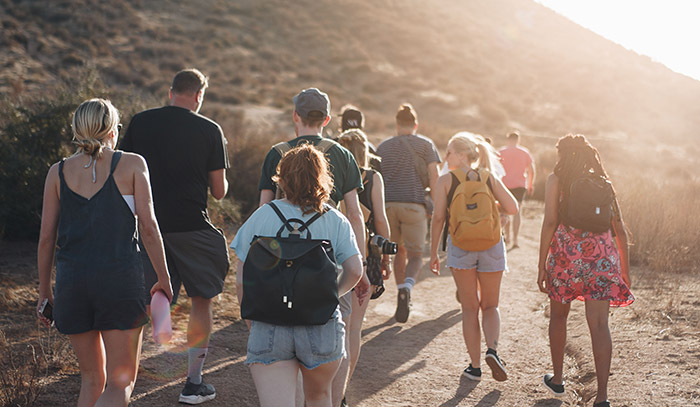What’s one of the biggest downsides of traveling solo?
There’s no one to split costs with!
Yes, it’s a bit of a luxury problem—but it’s real. When you’re footing the entire bill yourself, costs can add up fast and potentially cut your trip short.
After years of solo travel (and budgeting hard to keep going), I’ve pulled together my best money-saving strategies. This guide covers the biggest money drains—and how to outsmart them.
Executive Summary:
The top 3 expenses on any trip?
Transportation
Accommodation
Food
Cutting costs in these areas will stretch your budget the furthest. Let’s dive into transportation first:
1. Become a Flight Booking Ninja
Scoring cheap flights takes strategy—and the right tools.
The best all-around flight search tool is still Google Flights. It’s fast, clean, and super powerful:
Use the “Date Grid” or “Price Graph” to spot cheaper days to fly.
Leave the destination blank and search from your departure city—perfect if you’re open to adventure.
Get alerts to track prices for specific routes.
Other solid tools include:
Skyscanner for comparing deals globally
Hopper for AI-driven predictions (especially useful on mobile)
Best booking strategies:
Book flights at least 3–6 weeks in advance
Fly midweek: Tuesday, Wednesday, or Saturday usually offer better prices
Consider early-morning flights—they’re cheaper and less likely to be delayed
Look at alternate airports near your destination (e.g., fly into OAK instead of SFO)
⚠️ Avoid holiday spikes. Prices surge around Christmas, New Year’s, and peak summer dates. If you can, travel during shoulder seasons (like May or September) to avoid the crowds and save money.

2. Say No To Baggage Fees
Checked bags are where “budget airlines” make their money—but you can beat them at their own game.
How to avoid paying extra:
Travel with just one carry-on backpack
Make sure your bag fits the airline’s carry-on size and weight limits (Tip: check sites like Carry-On Size Checker or TravelMadeSimple for updated airline rules)
Yes, it’s a hassle at first, but once you experience the freedom of traveling light, you won’t go back. You’ll move faster, spend less, and stress way less at airports.
And remember: that $40 “cheap” flight isn’t so cheap once you tack on a $35 bag fee each way.

3. Use Credit Card Points To Fly For Free
Travel hacking with credit card points still works in 2025—and it can save you hundreds (or thousands) on flights.
But beware: it’s a rabbit hole.
Quick overview:
Get a travel credit card with a big sign-up bonus (e.g. 60,000+ points after $4,000 spend)
Time it with big expenses (e.g. new laptop, rent, or business travel reimbursement)
Keep your points in a flexible system like Chase Ultimate Rewards, Amex Membership Rewards, or Capital One Miles
Use AwardHacker or Point.me to find the best redemption options
Transfer points to an airline partner only once you’ve confirmed award seat availability
📌 Pro tip: These strategies work best for U.S. travelers. If you’re outside the U.S., look for cashback cards with no foreign transaction fees instead.
Resources like The Points Guy, One Mile at a Time, and the r/churning subreddit are great if you want to go deep.
4. Embrace the Stopover
Why fly straight through when you can explore two cities for the price of one?
A stopover is just a long layover (24+ hours) in a connecting city. Some airlines even offer stopover programs with hotel discounts or tours.
Great stopover cities:
Istanbul with Turkish Airlines
Reykjavik with Icelandair or PLAY
Singapore with Singapore Airlines (tiny, safe, and fun for 1–2 days)
Tokyo with ANA or Japan Airlines
Doha or Dubai with Qatar or Emirates (modern hubs with wild architecture)
Lisbon or Madrid with TAP or Iberia
Use Google Flights’ “multi-city” option to plan your route manually and see what combos work.
🕵️♂️ Advanced trick:
Try “hidden city ticketing” with Skiplagged—where the cheapest ticket includes your real destination as a layover.
⚠️ But be careful:
Never check a bag (it goes to the final destination)
Don’t do this for round-trip bookings or with the same airline often—they may penalize you

5. Take long-haul buses and save big
Flying isn’t always the cheapest—or most scenic—option.
In many parts of the world, buses are legit:
Reclining seats
Wi-Fi & charging ports
Onboard meals and snacks
Often cheaper than trains or flights
I once took a luxury overnight bus from Buenos Aires to Mendoza—13 hours, comfy bed, wine service, and I slept through most of it.
🚌 Buses worth considering:
FlixBus in Europe and North America
RedCoach in the U.S.
Oltursa and Cruz del Sur in South America
SETRA or Scania buses in Southeast Asia
🔒 Safety tip: Keep valuables with you at all times. If stashing a bag above you, use a mini lock or carabiner for extra peace of mind.

6. Public transport is your friend
Taxis and Ubers drain your wallet fast. When in doubt, go local.
Public transit systems in cities like Seoul, Singapore, Tokyo, Paris, Berlin, and Bangkok are safe, efficient, and super cheap.
📱 Use Google Maps, Moovit, or Citymapper for real-time route info (most now support offline use, too).
If you’re staying in one city for a few days, grab a:
Transit pass (daily/weekly)
Reloadable card (like Oyster in London, Suica in Tokyo)
You’ll save money and skip the hassle of figuring out fares every ride.
7. Avoid the dreaded airport taxi
So you’ve scored a great deal on your flight and found budget-friendly accommodation. But one final hurdle awaits: getting from the airport to the city without draining your wallet.
This is where many travelers give in. After a long-haul flight, queues at immigration, and maybe a slightly-too-intense conversation with customs, the idea of sinking into a taxi feels like salvation — even if it costs $60+ for a 15-minute ride.
But resist! Airport taxis are often the most overpriced option around. Unless you’re arriving at 2 a.m. with zero alternatives, avoid them.
Here’s what to do instead:
Research airport transport options in advance — airport shuttle, express bus, metro, or train. City guides and travel forums (or even Reddit) are gold mines for this info.
Ask at the info desk in Arrivals. Airport staff usually know the fastest, cheapest way into town.
Use ride-hailing apps like Uber, Bolt, or Grab. Prices vary, but they’re typically more transparent than taxis.
Check if your accommodation offers a pickup service — some hostels and Airbnbs do, especially in Southeast Asia and Eastern Europe.
Pro tip: If a taxi is unavoidable:
Ask for the fare up front.
Confirm if credit cards are accepted — and make sure the terminal actually works. “System error” is often code for “pay me in cash.”
Use official taxi stands only — never follow someone offering a ride inside the terminal.

8. Hostels are not always the best option
Backpackers love hostels. But that doesn’t mean they’re always the smartest choice. In fact, many solo travelers fall into “hostel autopilot,” overlooking better deals on private rooms, guesthouses, or apartment rentals.
Let’s break it down by destination:
Hanoi, Vietnam: Hostel beds go for $5, sure. But a private hotel room with breakfast might be $15 or less — and that includes daily cleaning.
Chiang Mai, Thailand: Here long stays shine. You can rent a fully furnished studio apartment for a month for the price of a dorm bed — especially if you book directly or use local rental apps.
Lisbon, Portugal: Hostels are plentiful but often crowded. Compare with co-living spaces or short-term apartment lets on platforms like Flatio or Spotahome.
New York during peak season: Honestly? Consider staying in New Jersey or Queens and commuting in — hostels aren’t always cheaper, and they fill up fast.
The takeaway: Hostels can be great for socializing, but always compare:
Hotels
Private guesthouses
Airbnbs
Monthly apartment rentals
Use tools like Booking.com, Agoda, or even Google Maps for wide-ranging comparisons.
9. How to save on Airbnb
Airbnb can still offer great deals — if you know how to play the game. One of the best moves? Negotiating directly with the host, especially for longer stays.
If you’re planning to stay a week or more, reach out before booking. Try something like:
Hi [Host Name], I love your place and would like to stay from [Date] to [Date]. Since I’m planning to stay for [X nights], would you consider offering a discount? Airbnb shows the price as [$XXX] — would [$YYY] work for you instead? Thanks and hope to hear from you soon!
Some tips:
Message multiple hosts at once — don’t wait for one to reply.
Keep it polite and personal — a friendly tone increases your chances.
Traveling off-season? Hosts are more likely to negotiate when bookings are slow.
Bonus tip: Already staying in a place you love? Offer to extend your stay privately at a discount. Hosts often prefer direct bookings (and cash), especially if you’re clean, quiet, and respectful.
10. Use sleeper trains as your hotel
Europe’s rail network is better than ever, and sleeper trains are back in style — both for sustainability and savings.
Here’s why they work:
You travel while you sleep, saving both time and a night’s accommodation.
You arrive in the heart of the city — no airport transfers needed.
Many new sleeper trains now have privacy pods or female-only cabins for added comfort.
Some popular routes:
Vienna → Venice
Paris → Berlin
Stockholm → Hamburg
But beware:
Not ideal for light sleepers — even the smoothest train has its bumps.
Keep valuables close. Use a travel belt or pillow-safe for passports, cards, and cash.

11. Get creative with accommodation
Who says a “bed” has to be a bed? Solo travelers are masters of improvisation — and sometimes, unusual accommodations make for the best stories.
Here are a few surprisingly legit options:
Capsule hotels (Japan, Korea): Futuristic pods with just enough space to sleep. Safe, quiet, and surprisingly comfy.
24-hour cafes (Korea, Taiwan): Many internet cafés offer reclining chairs, blankets, snacks, and showers. Some even rent them by the night.
Public bathhouses (China, Japan): Think more spa than sketchy. For a small fee, you get lockers, showers, and sometimes even a nap room.
House-sitting: Websites like TrustedHousesitters are still a great option — especially for longer stays. Pet care might be required, but in exchange, you stay free.
Couchsurfing alternatives: The original site is less active now, but check out BeWelcome or Host a Sister (for solo female travelers).
Airport sleeping: Yes, this is a thing. Sites like SleepingInAirports.net help you find the best benches, quiet zones, and even lounges for snoozing during a layover.
Pro tip: Walk-in hotel deals still exist! If you’re stranded or just like the look of a place, walk in and ask the front desk for their best last-minute rate. Apps like HotelTonight or Dayuse can also help find deals near you.

12. Cooking for one: worth it?
Solo cooking while traveling is… complicated. But not impossible. Whether it’s worth it depends on your travel style, location, and access to a kitchen.
Let’s break it down:
Breakfast: Definitely worth it. A few groceries (eggs, fruit, oats) go a long way. Bonus: saves you from hangry morning restaurant hunts.
Lunch: Usually not worth it. Street food or local lunch menus often beat DIY sandwiches on both taste and price.
Dinner: Sometimes worth it — especially on longer stays or when you’re burned out from eating out. Pasta, omelets, stir-fry — easy, fast, cheap.
Must-haves if you’re cooking:
A kitchen (obviously)
Basic equipment (frying pan, oil, salt)
Access to a supermarket or fresh market
Pro tip: Want to save but skip the cooking? Look for:
Local markets with ready-to-eat meals
Convenience store bentos (Japan, Korea)
Street food everywhere else
And if you do cook? Share your masterpiece with other travelers — or invite a new friend over for dinner. Cooking connects people, even on the road.

13. Dine with the office workers
If you’re looking for affordable and authentic meals, follow the locals—especially during weekday lunch hours. Office workers know where the best budget eats are, and they don’t waste time or money on overpriced tourist traps.
This trick works particularly well in pricey areas—think Ginza in Tokyo, Midtown in NYC, or central London—where restaurants catering to locals offer fixed-price lunch specials that are high in quality and low in cost.
A few quick pointers:
Look for crowded, no-frills places around 12–1:30pm.
Don’t ask for the “cheapest” food—ask for the tastiest with big portions. Locals will respect that more.
Skip the Western food unless it’s a local specialty—you’re more likely to overpay and under-enjoy.
Bottom line: Eat local, and eat where the locals do. Not only will you save money, but you’ll also enjoy a more authentic culinary experience.
14. Book tours locally
Booking tours in advance online might seem like the safe move, but you’ll often end up paying a premium—especially through aggregator sites that tack on hefty commission fees.
In most parts of the world, booking tours on the ground still gives you the best value. You can compare prices, ask detailed questions, and sometimes even negotiate last-minute discounts (especially if you’re a solo traveler filling a spare slot).
Here’s how to play it smart:
Wait until you’re in the city to scope out tour shops or hostel recommendations.
If a tour’s leaving the next day and there’s still space, ask for a walk-in or cash discount.
Always ask if any extras (meals, transport, gear rental) are included.
🚨 Pro Tip: Got a drone or a slick smartphone camera? Some smaller operators may still trade a discount for high-quality photos or short video reels—especially if you’re willing to tag them on social media.
And if you do want to pre-book online, check for local tour operators with direct websites, or message them via WhatsApp to negotiate better rates than the big booking platforms.
15. Exchanging money (and withdrawing cash) like a pro
Repeat after me: Don’t use airport currency exchange counters unless you’re absolutely desperate.
You’ll get far better rates using a bank ATM in town, ideally one inside a bank branch (for safety and reliability). Avoid standalone machines in tourist zones—they’re more prone to skimming or inflated fees.
Some updated money-saving tips:
Use a travel-friendly debit card. Charles Schwab still refunds ATM fees, and Wise (formerly TransferWise) now offers great debit cards with low conversion costs.
Use a no-foreign-transaction-fee credit card for most purchases. They offer the best exchange rate and fraud protection.
Always choose to be charged in the local currency. Let your bank handle the conversion, not the local vendor’s “dynamic currency conversion” system—it’s usually a ripoff.
Stash emergency cash. Keep around $200 in a secure spot, half in USD and half in local currency. You never know when an ATM won’t work or cards get frozen.
And don’t forget:
Set travel alerts with your bank or use apps that let you manage this on the go.
Google “currency exchange near me” and check reviews before stepping into any unfamiliar spot.
Tipping norms vary—look them up before you arrive. In many countries, service is included or tipping is optional.
🛡️ Pro Safety Tip: Use only ATMs inside major bank branches to minimize fraud risk.

16. Bring your student ID
Still a student? You’re sitting on a treasure trove of discounts.
From public transport to museums to adventure activities, your student ID can slash costs across the board. Some countries even offer student-only ticket classes.
If you can, sign up for an ISIC card (International Student Identity Card) before departure—it’s the most widely accepted international student proof.
Don’t forget to ask about student pricing even if it’s not advertised. Many discounts are off-the-menu.
💡 Bonus tip: Even if you’re not a current student, some discounts apply for those under 26—check ahead!
17. Sign up for some walking tours
Free (or tip-based) walking tours are still one of the best deals in travel.
Offered in nearly every major city, these tours are an amazing way to get your bearings, learn the local history, and connect with fellow travelers. Most last 2–3 hours, and tipping $10–$20 USD (or local equivalent) is customary if you enjoyed it.
Here’s why they’re worth it:
You’ll hear the fun, short, and engaging version of the city’s story.
You’ll get local tips from someone who knows what’s good and what’s a tourist trap.
You’ll meet people. These tours are a great social icebreaker for solo travelers.
🧠 Pro idea: Do a walking tour in your hometown before you leave. It’ll give you a fresh appreciation for where you’re from—and show you what kind of tour to look for abroad.

18. Don’t sweat the small stuff
Last but not least: don’t lose sight of the big picture.
Travel is about experiences, not optimization. Saving $2 here and there is great—but not if it sucks the joy out of your trip.
Don’t be the traveler wearing $400 worth of gear who argues over a 75-cent metro surcharge. Or the one skipping out on once-in-a-lifetime experiences just to keep the daily spend under $25.
Sometimes, the best memories come from saying yes to things that weren’t in the plan.
So:
If you find an unexpected adventure that costs a bit more—take it.
If you’re drinking with good people, don’t skip the round just to save a few bucks.
Trust that when it’s all said and done, you won’t regret spending money on meaningful experiences.
✨ The real goal? To come home richer in memories, not necessarily richer in money.
I hope some of these tips help as you prep for your next solo adventure!
Got your own pro hacks or favorite budget tricks? Share them in the comments—we all learn from each other.
Safe travels! ✈️🌍
PS. For a detailed comparison of major tour group operators, check out the full comparison article.
Or: check out one of our free destination guides (organized by region / country)!













